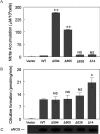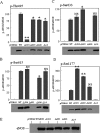The N-terminal portion of autoinhibitory element modulates human endothelial nitric-oxide synthase activity through coordinated controls of phosphorylation at Thr495 and Ser1177
- PMID: 24993645
- PMCID: PMC4122979
- DOI: 10.1042/BSR20140079
The N-terminal portion of autoinhibitory element modulates human endothelial nitric-oxide synthase activity through coordinated controls of phosphorylation at Thr495 and Ser1177
Abstract
NO production catalysed by eNOS (endothelial nitric-oxide synthase) plays an important role in the cardiovascular system. A variety of agonists activate eNOS through the Ser1177 phosphorylation concomitant with Thr495 dephosphorylation, resulting in increased ·NO production with a basal level of calcium. To date, the underlying mechanism remains unclear. We have previously demonstrated that perturbation of the AIE (autoinhibitory element) in the FMN-binding subdomain can also lead to eNOS activation with a basal level of calcium, implying that the AIE might regulate eNOS activation through modulating phosphorylation at Thr495 and Ser1177. Here we generated stable clones in HEK-293 (human embryonic kidney 293) cells with a series of deletion mutants in both the AIE (Δ594-604, Δ605-612 and Δ626-634) and the C-terminal tail (Δ14; deletion of 1164-1177). The expression of Δ594-604 and Δ605-612 mutants in non-stimulated HEK-293 cells substantially increased nitrate/nitrite release into the culture medium; the other two mutants, Δ626-634 and Δ1164-1177, displayed no significant difference when compared with WTeNOS (wild-type eNOS). Intriguingly, mutant Δ594-604 showed close correlation between Ser1177 phosphorylation and Thr495 dephosphorylation, and NO production. Our results have indicated that N-terminal portion of AIE (residues 594-604) regulates eNOS activity through coordinated phosphorylation on Ser1177 and Thr495.
Figures







Similar articles
-
Role of protease-activated receptor-1 in endothelial nitric oxide synthase-Thr495 phosphorylation.Exp Biol Med (Maywood). 2009 Feb;234(2):132-9. doi: 10.3181/0807-RM-233. Epub 2008 Dec 8. Exp Biol Med (Maywood). 2009. PMID: 19064940
-
Characterization of the roles of the 594-645 region in human endothelial nitric-oxide synthase in regulating calmodulin binding and electron transfer.J Biol Chem. 2000 Apr 28;275(17):13155-63. doi: 10.1074/jbc.275.17.13155. J Biol Chem. 2000. PMID: 10777622
-
Bupivacaine-induced contraction is attenuated by endothelial nitric oxide release modulated by activation of both stimulatory and inhibitory phosphorylation (Ser1177 and Thr495) of endothelial nitric oxide synthase.Eur J Pharmacol. 2019 Jun 15;853:121-128. doi: 10.1016/j.ejphar.2019.03.026. Epub 2019 Mar 15. Eur J Pharmacol. 2019. PMID: 30880179
-
Endothelial AMP-Activated Kinase α1 Phosphorylates eNOS on Thr495 and Decreases Endothelial NO Formation.Int J Mol Sci. 2018 Sep 13;19(9):2753. doi: 10.3390/ijms19092753. Int J Mol Sci. 2018. PMID: 30217073 Free PMC article.
-
Amlodipine activates the endothelial nitric oxide synthase by altering phosphorylation on Ser1177 and Thr495.Cardiovasc Res. 2003 Oct 1;59(4):844-53. doi: 10.1016/s0008-6363(03)00505-4. Cardiovasc Res. 2003. PMID: 14553824
Cited by
-
The Roles of Nitric Oxide Synthase/Nitric Oxide Pathway in the Pathology of Vascular Dementia and Related Therapeutic Approaches.Int J Mol Sci. 2021 Apr 26;22(9):4540. doi: 10.3390/ijms22094540. Int J Mol Sci. 2021. PMID: 33926146 Free PMC article. Review.
-
Dynamic changes of angiopoietins and endothelial nitric oxide supply during fluid resuscitation for major gyn-oncological surgery: a prospective observation.J Transl Med. 2020 Jan 31;18(1):48. doi: 10.1186/s12967-020-02236-9. J Transl Med. 2020. PMID: 32005259 Free PMC article.
-
Nitric oxide: what's new to NO?Am J Physiol Cell Physiol. 2017 Mar 1;312(3):C254-C262. doi: 10.1152/ajpcell.00315.2016. Epub 2016 Dec 14. Am J Physiol Cell Physiol. 2017. PMID: 27974299 Free PMC article. Review.
-
Generation and characterization of functional phosphoserine-incorporated neuronal nitric oxide synthase holoenzyme.J Biol Inorg Chem. 2019 Feb;24(1):1-9. doi: 10.1007/s00775-018-1621-1. Epub 2018 Oct 12. J Biol Inorg Chem. 2019. PMID: 30315355 Free PMC article.
-
Featured Article: Differential regulation of endothelial nitric oxide synthase phosphorylation by protease-activated receptors in adult human endothelial cells.Exp Biol Med (Maywood). 2016 Mar;241(6):569-80. doi: 10.1177/1535370215622584. Epub 2016 Jan 4. Exp Biol Med (Maywood). 2016. PMID: 26729042 Free PMC article.
References
-
- Pollock J. S., Förstermann U., Mitchell J. A., Warner T. D., Schmidt H. H., Nakane M., Murad F. Purification and characterization of particulate endothelium-derived relaxing factor synthase from cultured and native bovine aortic endothelial cells. Proc. Natl. Acad. Sci. U. S. A. 1991;88:10480–10484. doi: 10.1073/pnas.88.23.10480. - DOI - PMC - PubMed
-
- McMillan K., Bredt D. S., Hirsch D. J., Snyder S. H., Clark J. E., Masters B. S. Cloned, expressed rat cerebellar nitric oxide synthase contains stoichiometric amounts of heme, which binds carbon monoxide. Proc. Natl. Acad. Sci. U. S. A. 1992;89:11141–11145. doi: 10.1073/pnas.89.23.11141. - DOI - PMC - PubMed
Publication types
MeSH terms
Substances
LinkOut - more resources
Full Text Sources
Other Literature Sources
Miscellaneous

